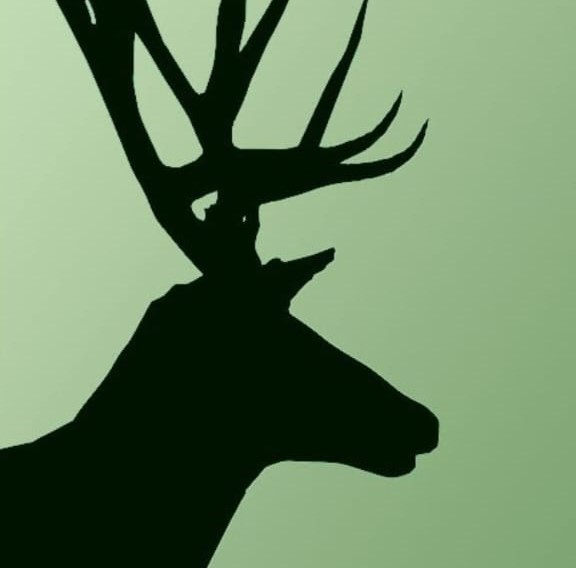Beavering About on Exmoor
by Celia Dillow, for Exmoor Magazine
There are beavers living on Exmoor. A pair of Eurasian beavers was introduced into an enclosure on the Holnicote Estate in 2020. It is part of the nationwide ‘Riverlands’ project, designed to restore health to our river systems. One year later, a baby beaver (a kit) was born. He was the first beaver to be born on Exmoor for 400 years. Conditions must suit them up here because there are now twelve animals in total. Five kits were born in August 2023, including a surprise set of triplets!
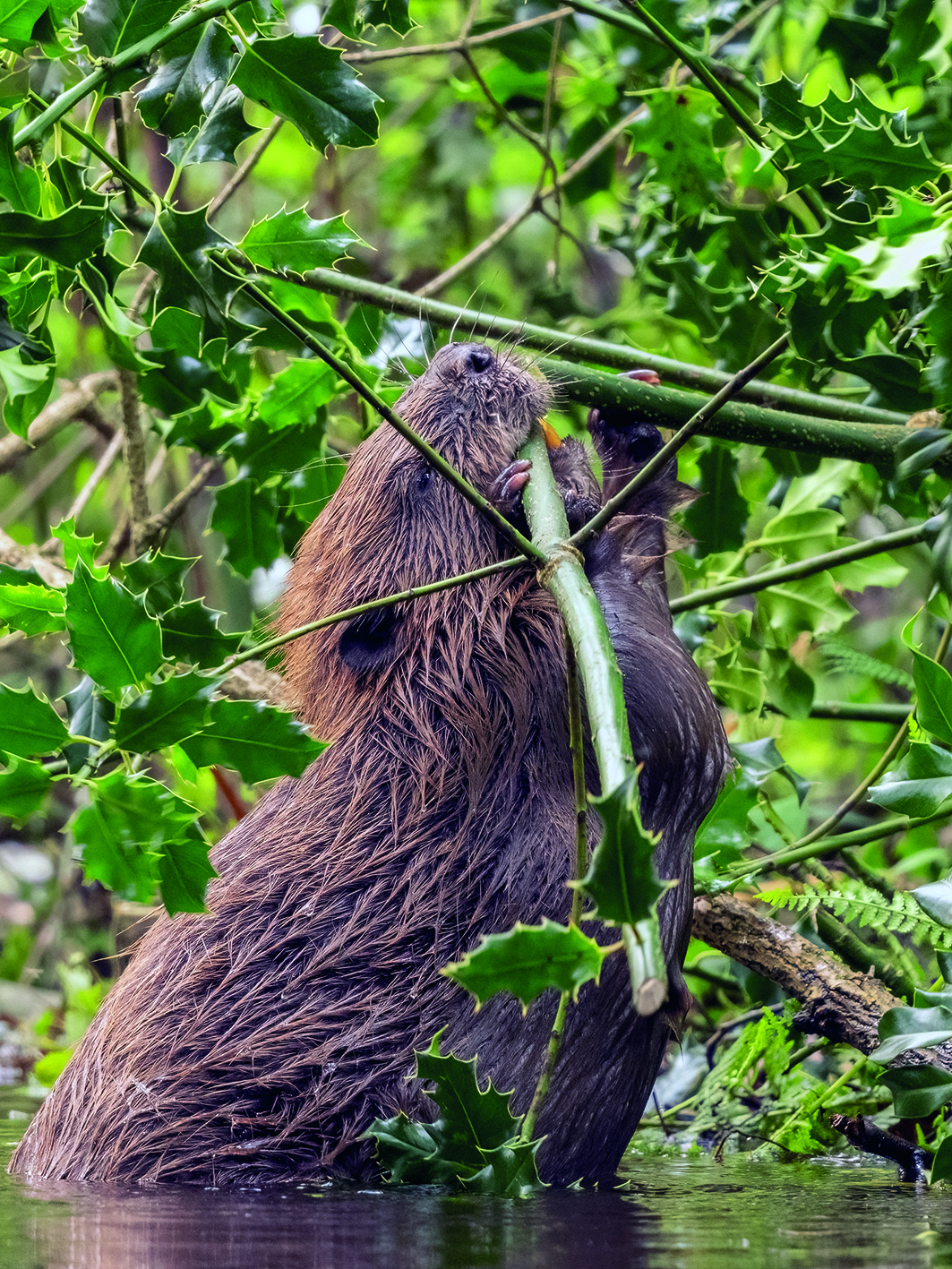
Beavers are fiercely territorial. They are in two family groups, in separate enclosures. “We don’t know if the kits are males or females yet,” said Jack Siviter, who manages the beaver enclosures for the National Trust. It is impossible to tell without catching them and the rangers handle the wild beavers as little as possible. It’s not easy to grapple with a beaver and causes stress for everyone. Eventually, however, the kits will be trapped, sexed and chipped. They will remain in their family groups until they are around 2-3 years old. This is important because beaver family life is rich and complex, with lots of nurturing, teaching and mentoring. At maturity, the young beavers would naturally disperse to find their own territories and at this point ‘our’ beavers will be moved to new enclosures, elsewhere in the UK. Beaver Trust and Natural England help to manage the movement of individual animals, ensuring a genetically diverse and healthy population.
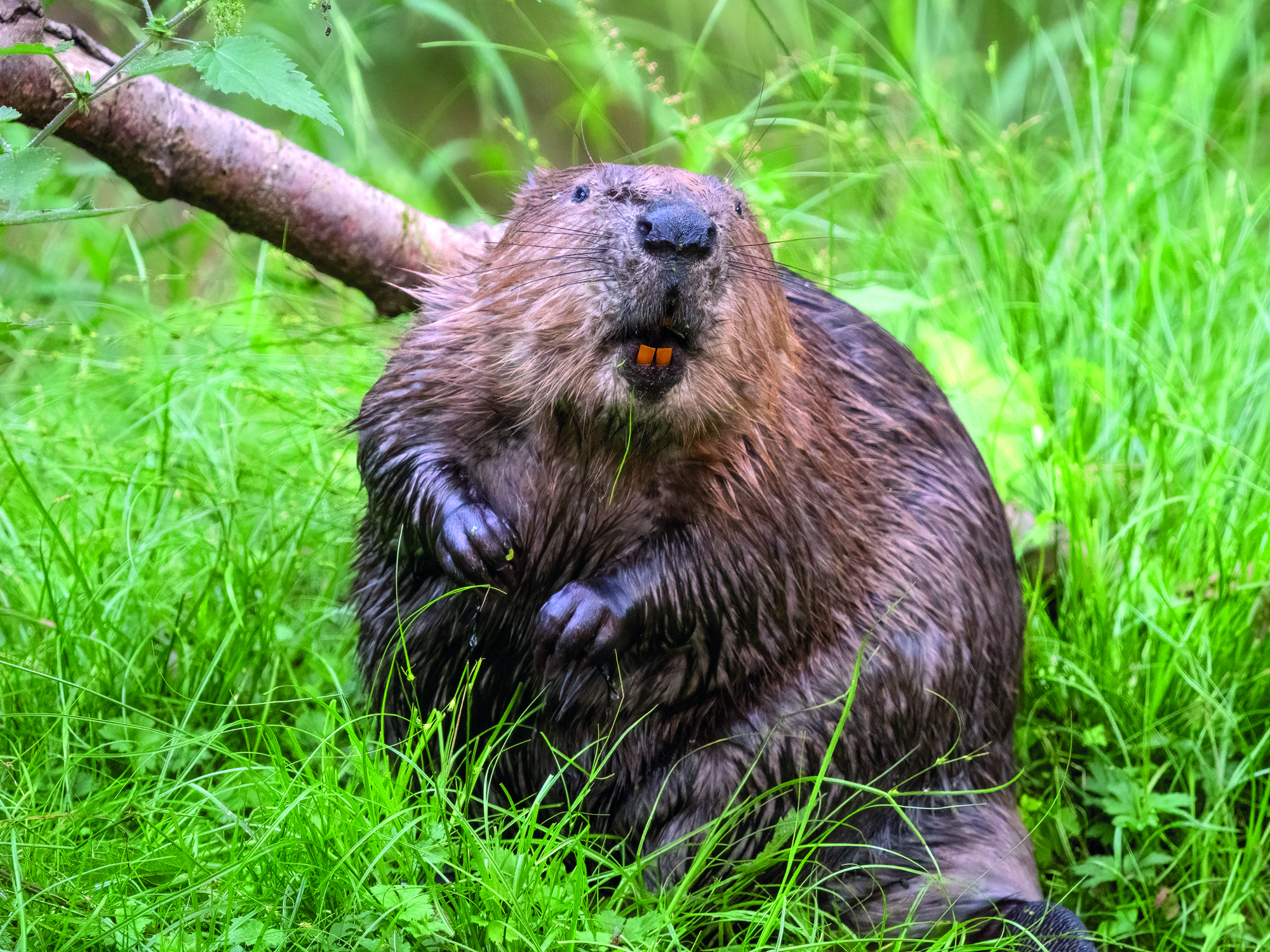
Beavers Past
The great furry rodents have shared this land with us for a long time, and 400,000 years ago they were giants! The European giant beaver, Trogontherium, was a couple of metres in length and in America they had beavers the size of a black bear! These days, our Eurasian beaver, Castor fiber, measures a mere metre from nose-tip to tail-tip. Their bones are buried in our rocks and traces of them are braided into placenames such as Beverton and Beverley, but they were hunted to extinction from the UK centuries ago.
We wanted their coats to make our coats. Beaver hats, made from their felted hair, were fashionable. Castoreum, produced in their scent glands, was highly prized by the perfume industry. Beaver meat was once a popular form of protein. However, beaver tails, now a popular Canadian delicacy, are just fried pastries which are shaped like a beaver paddle. No beavers are harmed or consumed in their production.

Beavers Present
Today, this keystone species is making a comeback. There are enclosed beaver trials across the UK and several free-living colonies have also established. They are enchanting animals, shaped like a stubby peardrop with a lustrous pelt: deep, soft, insulating and waterproof. They are the colour of cinnamon bark. The tail is a black, rubbery paddle. It is strong enough to rudder them through the water and flexible enough to sit on. Their leather-gloved front paws are extremely dexterous; back feet are large and webbed with a split claw specially adapted for grooming. Semi-aquatic, beavers are fast, elegant swimmers and can stay underwater for 15 minutes. Their startling front teeth are orange, coloured by the iron in their enamel. These are strong tools which can fell trees and strip bark. They eat a wide range of plants, grasses, twigs and leaves. New shoots are the most palatable and so they coppice the trees in their watery landscape, ensuring a fresh supply of new growth. They also create deep-water stores of cut vegetation so that they have easily accessible food throughout the winter months, even if there is a big freeze. And, although Mr and Mrs Beaver served trout and potatoes to the children in Narnia, beavers very definitely do not eat fish!

Busy Beavers
Beavers have a significant impact on the land. They build their famous dams to create the deep water which they need to move around safely and to cache their food. They create channels, lagoons and lawns with swampy, spongy edges. Their waterscapes become wetter, more wiggly and more diverse – with shallows and deeps; different water temperatures; stagnant pools and faster flows. They slow water and store water and filter water. The riverlands become resilient, protected against drought. The risks of flooding events downstream are lowered.
Beavers are natural regenerators. Habitats are restored and this attracts a range of other species such as kingfishers, water voles, amphibians, bats and dragonflies. The presence of beavers is a “sensible way to put life back into the landscape” Jack Siviter told me. So, what is the most surprising thing that Jack has learnt since he has been working with the beavers? “It’s a good question,” he said. He told me that he is impressed that their landscaping is not random, but planned: “They choose just the right point to dam and they take the water to the food” (to create their underwater caches). “Don’t get me wrong, they are not geniuses!” he added. “They do make mistakes and fell trees the wrong way, but their actions are intentional.”
Of course, due to the fact that beavers have a significant impact on the land, there is the potential for tension. Four centuries ago, when beavers last lived here, the land had not been shaped in the same way to suit and serve our purposes. There is less wild space now and beavers and people may need to adapt so we can live together again.
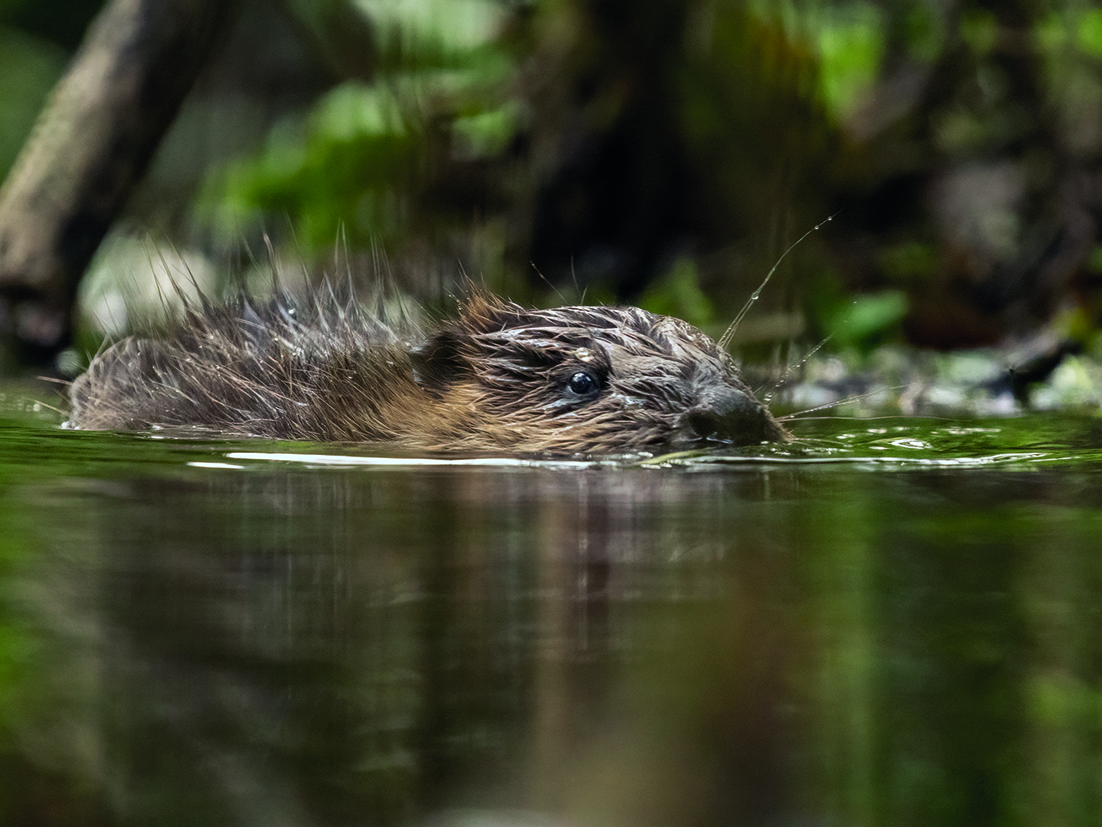
To find out more, why not visit our Exmoor beavers? There is an interactive, virtual tour of the Holnicote beaver enclosure (the link is included below). Visitors can navigate themselves around the habitat and investigate the dams, lodge and pools. It is an immersive and mindful experience, accompanied by the soft dabbling and fussing of water birds, the hiss of the wind in the reeds and water bubbling in the background. Fact boxes appear on the screen and there are clickable links to beaver clips, expert interviews and webcam footage. Why not grab a cuppa and jump in? It is an ideal way in which to learn more about these new and charming neighbours who were woven into the historic Exmoor landscape many thousands of years ago.
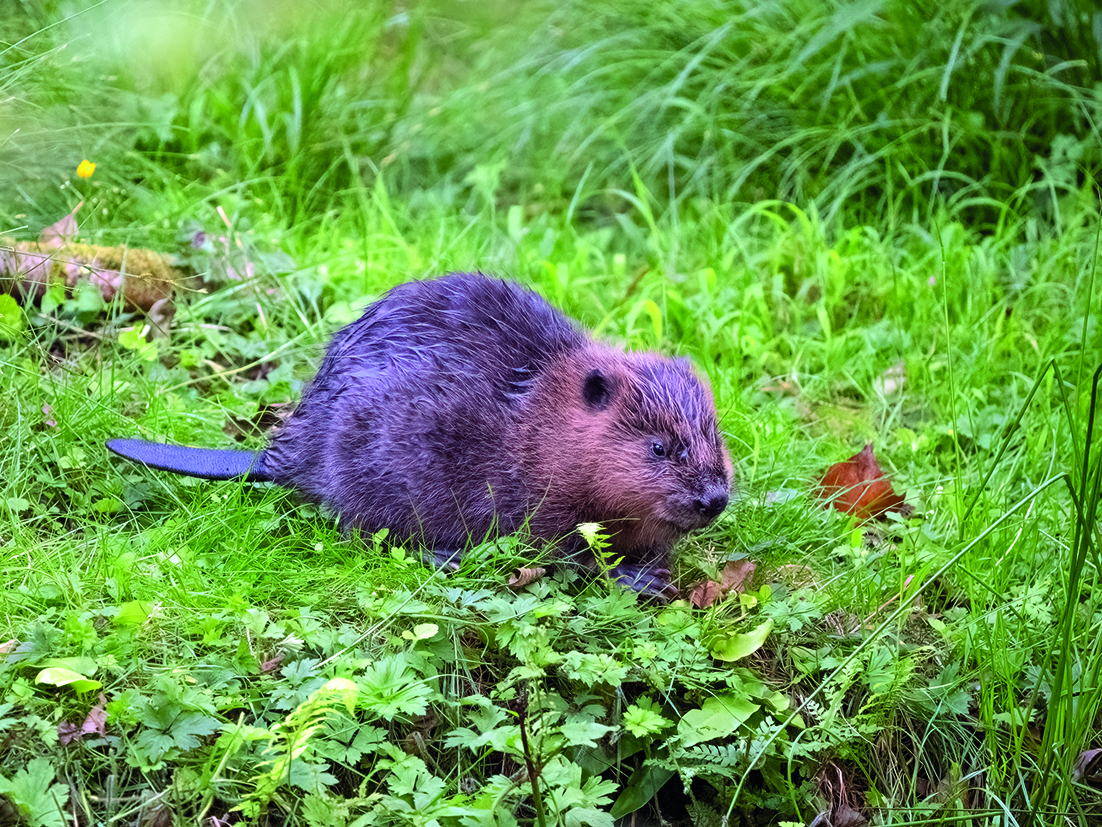
Find out more
Virtual tour of Holnicote Estate
Books: Bringing Back the Beaver, by Derek Gow, 2020; The Beaver Book, by Hugh Warwick, 2021; The Lion, The Witch and The Wardrobe, by C.S. Lewis, 1950.
PHOTOS FROM HOLNICOTE
Beavers 01: Female beaver copyright Barry Edwards.
Beavers 02: Female beaver showing her teeth, which are coloured orange by the iron in their enamel copyright Barry Edwards.
Beavers 03: Female beaver foraging copyright Barry Edwards.
Beavers 04: Beaver kit swimming copyright Barry Edwards.
Beavers 05: Female foraging copyright Barry Edwards.
Beavers 06: Female swimming copyright Barry Edwards.
Beavers 07: Female foraging copyright Barry Edwards.
Exmoor Magazine are working with us to provide a small hand-picked selection of articles for you to enjoy, that delve into the landscapes, ecology, history and cultural life of Exmoor.
Article is copyright of Exmoor Magazine. Find out more about receiving the magazine directly through your letterbox each season at www.exmoormagazine.co.uk facebook.com/exmoormagazine Instagram @exmoormagazine
Learn more about Exmoor’s wildlife including the Red Deer and Sea Eagles here
FAQ
A pair of Eurasian beavers was introduced to an enclosure on the Holnicote Estate in 2020 as part of the nationwide Riverlands project. One year later, the first beaver kit was born on Exmoor in 400 years. The population has now grown to twelve beavers in total, living in two separate family groups, including five kits born in August 2023 with a surprise set of triplets.
Beavers have orange teeth because of the iron in their enamel. These striking orange front teeth are incredibly strong tools that can fell trees and strip bark. The iron content makes them durable enough to handle the constant gnawing and tree-cutting that beavers do as part of their natural behaviour.
Beavers are natural regenerators that create diverse waterscapes with channels, lagoons, and varied water depths. They slow, store, and filter water, making riverlands more resilient against drought and reducing downstream flooding risks. Their activities restore habitats and attract other species including kingfishers, water voles, amphibians, bats, and dragonflies, essentially putting life back into the landscape.
Beavers eat a wide range of plants, grasses, twigs, and leaves, with new shoots being the most palatable. They coppice trees to ensure a fresh supply of new growth and create underwater food stores for winter. Despite the famous scene in Narnia where Mr and Mrs Beaver serve trout, beavers very definitely do not eat fish – they are strictly herbivorous.
Yes, there is an interactive virtual tour of the Holnicote beaver enclosure that allows you to navigate around their habitat and investigate the dams, lodge, and pools. The immersive experience includes natural sounds like water birds, wind in the reeds, and bubbling water, plus fact boxes, expert interviews, and webcam footage to help you learn about these fascinating animals.
Young beavers remain with their family groups until they are around 2 to 3 years old. This extended family time is important because beaver family life is rich and complex, involving lots of nurturing, teaching, and mentoring. Once they reach maturity, the young beavers would naturally disperse to find their own territories, at which point the Exmoor beavers will be moved to new enclosures elsewhere in the UK.
